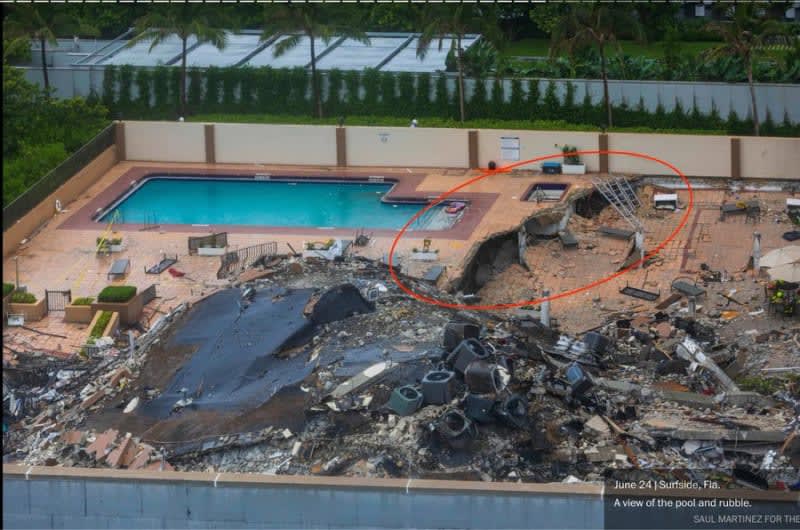Navigation
Install the app
How to install the app on iOS
Follow along with the video below to see how to install our site as a web app on your home screen.
Note: This feature may not be available in some browsers.
More options
Style variation
-
Congratulations TugboatEng on being selected by the Eng-Tips community for having the most helpful posts in the forums last week. Way to Go!
You are using an out of date browser. It may not display this or other websites correctly.
You should upgrade or use an alternative browser.
You should upgrade or use an alternative browser.
Miami Beach, Champlain Towers South apartment building collapse, Part 02 151
- Thread starter dik
- Start date
- Status
- Not open for further replies.
-
2
- #81
I think inspections with open and transparent results would be a good start. Then the owners would be strongly incentivized to maintain their own common property to preserve their individual unit property values. Bridge inspections can be boiled down to a 0 to 100% "sufficiency rating". If high-occupancy buildings had a structural inspection say, 15 years after opening and every 5 years following and a standardized inspection score made public, the free market would put a lot of pressure on owners to keep up with routine maintenance before it turns into a $15 million or 150+ fatality problem.
Real estate sites like Zillow or vacation rental sites like VRBO have all kinds of high level "scores": walkability scores, energy efficiency scores, solar energy potential, neighborhood livability, you name it. People love to rank, sort, and eliminate.
So, how hard and expensive would it be - given the stakes - to develop a "Structure and Systems Health Score" that is standardized and disclosed to potential buyers in a market. The issue of cost neutralizes quickly when comparable units in the building next door are selling for $100k more due to a 20 point better score.
Buildings will deteriorate eventually. We've all taken thermodynamics here; entropy marches on whether we acknowledge it or not. For most buildings, this means that someday the land will be worth more than the building, which will be torn down to build something new. In this case, the building didn't wait for the HOA to decide its fate. The end result was rare but tragic.
Bradley Wilder, P.E.
Construction P.E. (KY), MBA
Bridge Rehab, Coatings, Structural Repair
Real estate sites like Zillow or vacation rental sites like VRBO have all kinds of high level "scores": walkability scores, energy efficiency scores, solar energy potential, neighborhood livability, you name it. People love to rank, sort, and eliminate.
So, how hard and expensive would it be - given the stakes - to develop a "Structure and Systems Health Score" that is standardized and disclosed to potential buyers in a market. The issue of cost neutralizes quickly when comparable units in the building next door are selling for $100k more due to a 20 point better score.
Buildings will deteriorate eventually. We've all taken thermodynamics here; entropy marches on whether we acknowledge it or not. For most buildings, this means that someday the land will be worth more than the building, which will be torn down to build something new. In this case, the building didn't wait for the HOA to decide its fate. The end result was rare but tragic.
Bradley Wilder, P.E.
Construction P.E. (KY), MBA
Bridge Rehab, Coatings, Structural Repair
-
1
- #82
In my opinion, corrosion was not a significant cause of collapse.
Also lack of floor slope was not a significant cause of collapse.
If water containing corrosive chlorides runs over the floor over many years, and the floor has no membrane protection, the concrete will absorb the chlorides. Guaranteed, even if loped.
Among worst rebar corrosion I ever saw was top bars in steeply slope truck ramp.
I have seen very bad corrosion and spalling, including on bridges, but no collapse, and no indication of structural distress.
This does not mean it is not serious; it should always be reapired a quickly as possible. I always add "withoutd delay". Owner must not wait till management includes it in some far off budget.
Retired P.Eng.
Ontario, Canada
Also lack of floor slope was not a significant cause of collapse.
If water containing corrosive chlorides runs over the floor over many years, and the floor has no membrane protection, the concrete will absorb the chlorides. Guaranteed, even if loped.
Among worst rebar corrosion I ever saw was top bars in steeply slope truck ramp.
I have seen very bad corrosion and spalling, including on bridges, but no collapse, and no indication of structural distress.
This does not mean it is not serious; it should always be reapired a quickly as possible. I always add "withoutd delay". Owner must not wait till management includes it in some far off budget.
Retired P.Eng.
Ontario, Canada
Twenty-four Miami apartment buildings, including two county-owned structures, listed unsafe after audit
-
1
- #84
RickyTickyTavi
Structural
To be clear, ajk1, corrosion of the rebar is structural distress.
Your top bar deterioration example may have been in a location of low negative moment or you were observing temperature steel. Rebar corrosion of flexural steel and/or shear steel will result in a reduced cross sectional area of steel, the farther it deteriorates the more likely the remaining steel will yield and finally break. Like many things, rebar corrosion largely depends on which bars are corroding, how fast and where. For example, if the shear reinforcement on the transfer beam on the plan-east side of the building were corroding --- that could certainly lead to structural failure.
Your top bar deterioration example may have been in a location of low negative moment or you were observing temperature steel. Rebar corrosion of flexural steel and/or shear steel will result in a reduced cross sectional area of steel, the farther it deteriorates the more likely the remaining steel will yield and finally break. Like many things, rebar corrosion largely depends on which bars are corroding, how fast and where. For example, if the shear reinforcement on the transfer beam on the plan-east side of the building were corroding --- that could certainly lead to structural failure.
-
3
- #87
ajk1 said:In my opinion, corrosion was not a significant cause of collapse.
Also lack of floor slope was not a significant cause of collapse.
If water containing corrosive chlorides runs over the floor over many years, and the floor has no membrane protection, the concrete will absorb the chlorides. Guaranteed, even if loped.
Among worst rebar corrosion I ever saw was top bars in steeply slope truck ramp.
I have seen very bad corrosion and spalling, including on bridges, but no collapse, and no indication of structural distress.
This does not mean it is not serious; it should always be reapired a quickly as possible. I always add "withoutd delay". Owner must not wait till management includes it in some far off budget.
Retired P.Eng.
Ontario, Canada
+1
I repair deteriorated concrete structures for a living (also in Ontario). I walk into underground parking garages on a daily basis (with no immediate plans for repair) that indicate significantly more distress than what the pictures we have been seeing seem to show. Hell, go take a drive under the Gardiner expressway in Toronto to see one above you! Some of those bents, my oh my.
I'm not saying that is "okay" but I when one has seen 100s if not 1000s of deteriorated concrete structures, all of which stand up even when you look at them and go "...how??" I find it very hard to attribute this failure predominantly due to deterioration (surely played a part but I cannot fathom a large one). Caveat: based on the pictures we have seen. Perhaps something was so deteriorated that it was the prime culprit, but we havent seen it yet.
The fact that this thing was constantly flooded is much more suspect to me. How can an UPG be flooded all of the time and you not have soil issues? I would be looking there.
Engineers carry all the responsibility and yet have none of the authority.
Expecting us to speak up and be whistleblowers is proven to not work, and what a terrible process that is.
People need a job and paycheque, they have a family and bills to pay. Whistleblowing ends that potentially your career, and can you personally finance that lawsuit against you now?
I think after the design and construction phases, these "inspectors" are a plague. The people aren't fully qualified, they seem to be easily bought, and play into politics.
Afterwards, there is no mandate to get the repairs done or follow up to see if they were. I can understand a multimillion dollar special assessment taking time to collect funds but it seems to take many years to begin to get repair work moving forward.
"Miami-Dade inspectors have more than 1,000 active cases before the board for overdue recertifications"
Two apartments of 24 on the latest 24 Enforcement Recertification Cases are dated 2008, what they are waiting for?
Expecting us to speak up and be whistleblowers is proven to not work, and what a terrible process that is.
People need a job and paycheque, they have a family and bills to pay. Whistleblowing ends that potentially your career, and can you personally finance that lawsuit against you now?
I think after the design and construction phases, these "inspectors" are a plague. The people aren't fully qualified, they seem to be easily bought, and play into politics.
Afterwards, there is no mandate to get the repairs done or follow up to see if they were. I can understand a multimillion dollar special assessment taking time to collect funds but it seems to take many years to begin to get repair work moving forward.
"Miami-Dade inspectors have more than 1,000 active cases before the board for overdue recertifications"
Two apartments of 24 on the latest 24 Enforcement Recertification Cases are dated 2008, what they are waiting for?
NOLAscience
Structural
ajk1:
We are not saying that rebar corrosion meant that there was loss of cross-section of the rebar; what we are saying is that the expanding rust pushed away the concrete that then fell away. That concrete was needed in the cross-section of the column. You say, "although I did see one photo where the delaminatio[n] was horrendous". Isn't that enough to evacuate the building?
"Some type of monitoring system should be installed as soon as possible without delay in the remaining budings of this design if people are to return to them." I think you are placing too much faith in a high tech solution. What are you going to monitor? The lateral deflection of a column? EVERY column? Which ones? Let's say the monitor shows 1/2" movement. Do you evacuate the building immediately? Is there enough time for everyone to get out before the column and the building collapse?
Spartan5:
The professional engineer (his stamp does not indicate his specialty; may have been 'grandfathered' in the 60s; he looks to be almost 80 years old) may have recognized that there was a problem. He gave the board his recommendations. I'm sure he expected that they would repair within a year or two. My only complaint with his report is that he did not recommend temporary shoring of the columns and slabs. That could have been done immediately, for less than $100,000, and we would not be studying this building because it would not have collapsed.
2bradw1128:
It took many failures for your branch of the industry to recognize the need for the inspections you describe.
StrucDesignPE:
Right -- the inspections could probably start at 15 years, and then be repeated every 5 years. Each inspection should have the power to call for a more in-depth inspection if certain categories of problems are noted. The inspections should have the proviso that the building's occupancy permit will be rescinded unless there is a contract in place for the repairs or mitigation within one year of the date of the report.
"So when a condo sells in this complex does the seller have an obligation to disclose any correspondence about the repairs recommended in 2018?"
I cannot see any reason why a buyer would NOT have an obligation to disclose, but one woman bought her condo in December 2020 with no info on the report or the problems. Disgraceful.
OHIOMatt:
"We must find a different approach to building safety. I have personally found that the building departments are ill equipped to handle any project of greater scale than a house. Look no further than New Orleans....yet the city issued a permit."
The city of New Orleans does not train its inspectors to inspect high-rise construction. There just aren't enough projects to make that feasible. Inspection is intended to protect the general public from poor design or bad contractors. Large projects are expected to have on hand building inspectors and experts who can insure the construction is done to specs.
We are not saying that rebar corrosion meant that there was loss of cross-section of the rebar; what we are saying is that the expanding rust pushed away the concrete that then fell away. That concrete was needed in the cross-section of the column. You say, "although I did see one photo where the delaminatio[n] was horrendous". Isn't that enough to evacuate the building?
"Some type of monitoring system should be installed as soon as possible without delay in the remaining budings of this design if people are to return to them." I think you are placing too much faith in a high tech solution. What are you going to monitor? The lateral deflection of a column? EVERY column? Which ones? Let's say the monitor shows 1/2" movement. Do you evacuate the building immediately? Is there enough time for everyone to get out before the column and the building collapse?
Spartan5:
The professional engineer (his stamp does not indicate his specialty; may have been 'grandfathered' in the 60s; he looks to be almost 80 years old) may have recognized that there was a problem. He gave the board his recommendations. I'm sure he expected that they would repair within a year or two. My only complaint with his report is that he did not recommend temporary shoring of the columns and slabs. That could have been done immediately, for less than $100,000, and we would not be studying this building because it would not have collapsed.
2bradw1128:
It took many failures for your branch of the industry to recognize the need for the inspections you describe.
StrucDesignPE:
Right -- the inspections could probably start at 15 years, and then be repeated every 5 years. Each inspection should have the power to call for a more in-depth inspection if certain categories of problems are noted. The inspections should have the proviso that the building's occupancy permit will be rescinded unless there is a contract in place for the repairs or mitigation within one year of the date of the report.
"So when a condo sells in this complex does the seller have an obligation to disclose any correspondence about the repairs recommended in 2018?"
I cannot see any reason why a buyer would NOT have an obligation to disclose, but one woman bought her condo in December 2020 with no info on the report or the problems. Disgraceful.
OHIOMatt:
"We must find a different approach to building safety. I have personally found that the building departments are ill equipped to handle any project of greater scale than a house. Look no further than New Orleans....yet the city issued a permit."
The city of New Orleans does not train its inspectors to inspect high-rise construction. There just aren't enough projects to make that feasible. Inspection is intended to protect the general public from poor design or bad contractors. Large projects are expected to have on hand building inspectors and experts who can insure the construction is done to specs.
JStructuralsteel said:Spartan5, If I condemned every building that had rebar issues or cracks, i would be out of business. Yes, the engineer did say its critical, but no engineer could predict this type of failure at the time of inspection. Who knows what happened even since April?
It would have to be a State wide agency, and then again, who is going to pay for it? $$$ matter, even in a disaster.
Your first statement illustrates the point I was drawing at to some extent.
“but no engineer could predict this type of failure at the time of inspection”
Then what is it a state agency solves?
If the inspection wasn’t sufficient, is something even more comprehensive required?
MINIMUM INSPECTION PROCEDURAL GUIDELINES FOR BUILDING STRUCTURAL RECERTIFICATION said:Cast in place reinforced concrete slabs and/or beams and joists may often show problem due to corroding rebars resulting from cracks or merely inadequate protecting cover of concrete. Patching procedures will usually suffice where such damage has not been extensive. Where corrosion and spalling has been extensive in structurally critical areas, competent analysis with respect to remaining structural capacity, relative to actual supported loads, will be necessary. Type and extent or repair will be dependent upon the results of such investigation.
2018 report said:Abundant cracking and spalling of varying degrees was observed in the concrete columns, beams, and walls. Several sizable spalls were noted in both the topside of the entrance drive ramp and underside of the poot/entrance drive/planter slabs, which included instances with exposed, deteriorating rebar. Though some of this damage is minor, most of the concrete deterioration needs to be repaired in a timely fashion. All cracking and spalling located in the parking garage shall be repaired in accordance with the recommendations of ICRt.
That was in 2018. In June of 2020 the same consultant was hired to prepare and had been working on a "40-year Building and Repair and Restoration" plan. Would that not require additional extensive inspection and analysis to prepare a comprehensive design?
(maybe I'm quoting a quote?)NOLAscience (Structural)29 Jun 21 19:39 said:"So when a condo sells in this complex does the seller have an obligation to disclose any correspondence about the repairs recommended in 2018?"
In California, The Realtor is legally required to disclose this. Also, if there is a lending bank, they require lots of documentation from the condo association about pending lawsuits and deferred maintenance. Realtors do get sued for failing to disclose (almost anything) here.
SF Charlie
Eng-Tips.com Forum Policies
NOLAscience said:The professional engineer (his stamp does not indicate his specialty; may have been 'grandfathered' in the 60s; he looks to be almost 80 years old) may have recognized that there was a problem. He gave the board his recommendations. I'm sure he expected that they would repair within a year or two. My only complaint with his report is that he did not recommend temporary shoring of the columns and slabs. That could have been done immediately, for less than $100,000, and we would not be studying this building because it would not have collapsed.
The same consultant was retained in June of 2020 to complete the design of all of the repairs. They produced this 84 sheet set of drawings to that effect. Is it silly to think there would have been additional inspection and analysis that went into all of that? I can’t believe they completed their entire design on the basis of that brief 2018 report.
-
2
- #93
Assuming the pool deck did collapse first, as seems apparent due to eye witness reports, the collapse force would have been not only vertical, but it would have had a horizontal component. Enough to pull a 12 storey building over, one with not much shear wall capacity? Perhaps. Brings up the age old question of structural separation. Should the pool deck have been a separate structure? Probably.
JStructsteel
Structural
Hokie66
I asked that above. If it failed, and collapsed leaving the lowest column un-braced, then I can see that. Progressive collapse. There were some reports of cracks opening up hours before the collapse.
I see a lawsuit saying the additional roof weight for the roof work caused it. I would assume the building (or that column line) was not at 100% live load and DL. again, not sure on the deterioration at that location. But the lawyers know.
I asked that above. If it failed, and collapsed leaving the lowest column un-braced, then I can see that. Progressive collapse. There were some reports of cracks opening up hours before the collapse.
I see a lawsuit saying the additional roof weight for the roof work caused it. I would assume the building (or that column line) was not at 100% live load and DL. again, not sure on the deterioration at that location. But the lawyers know.
- Thread starter
- #95
-
1
- #96
The pool didn't collapse, so this discussion about the pool is not relevant to the building collapse.
The roof work needs to be reviewed more thoroughly, it was occurring directly over where the collapse started. A few questions:
- Did the roof workers use any heavy equipment requiring shoring?
- Was the standing water near Space #78 there because the roof workers had taken the roof waterproofing off to replace it and water infiltrated the building (adding weight)?
- Did they use a tarp that may have collected water increasing the weight at the roof level and subsequent column loading?
- Were they drilling into the columns to install roof anchors, could this vibration have caused a failure at a lower level in an already compromised column?
- Did the bootleg penthouse addition contribute by overloading the columns?
-W
Typical Floor Plan (Floors 9-12 shown, 1-8 similar):
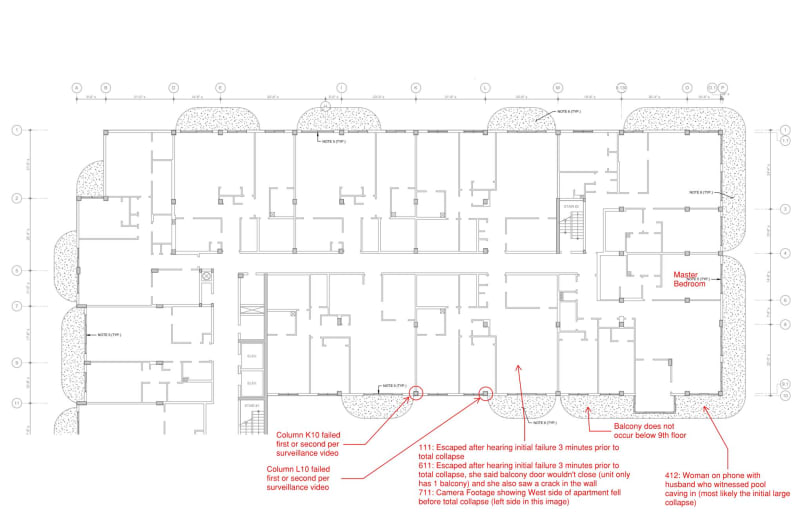
Surveillance Video Capture:
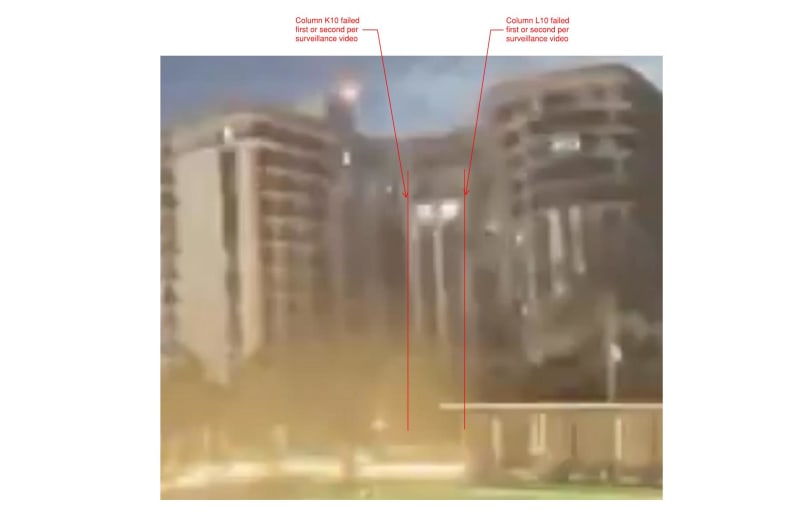
Garage Plan:
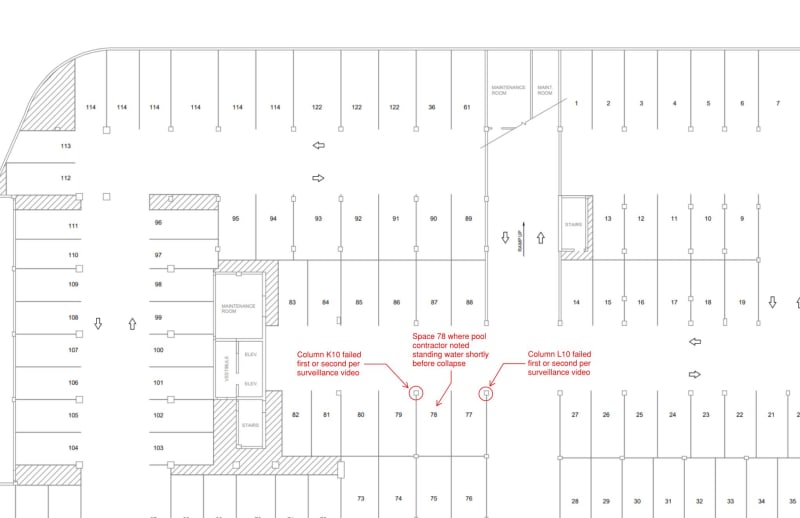
Roof/Penthouse Plan:
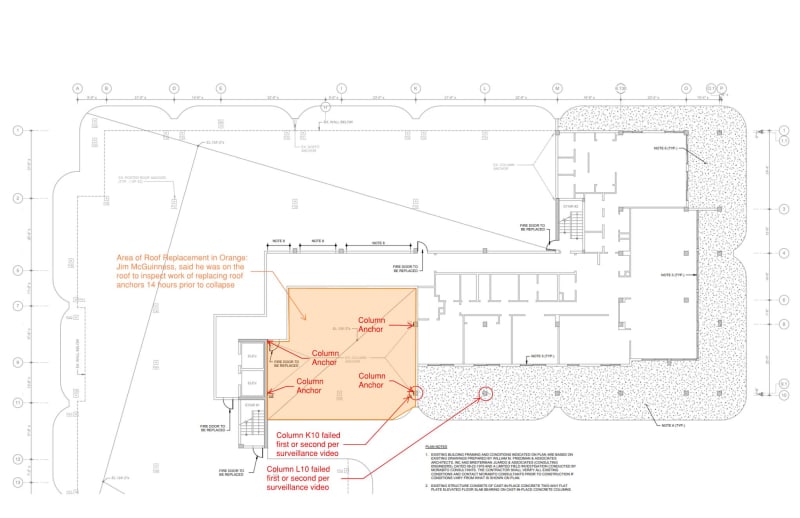
View of Roof After Collapse:
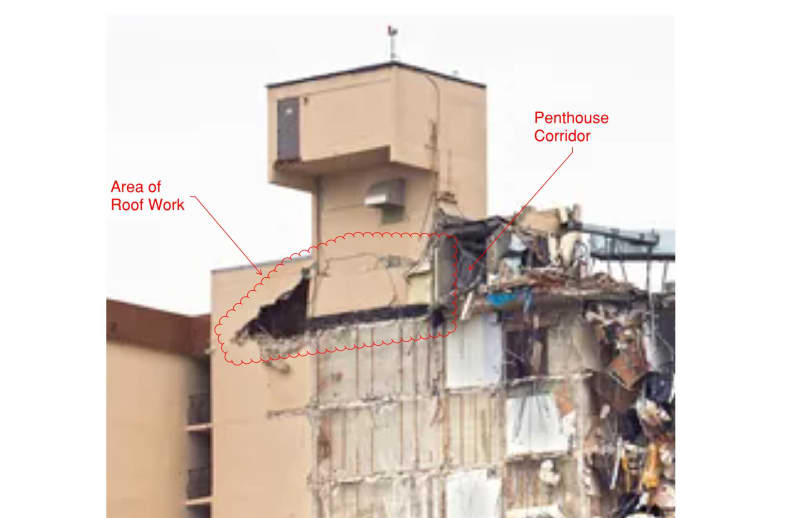
The roof work needs to be reviewed more thoroughly, it was occurring directly over where the collapse started. A few questions:
- Did the roof workers use any heavy equipment requiring shoring?
- Was the standing water near Space #78 there because the roof workers had taken the roof waterproofing off to replace it and water infiltrated the building (adding weight)?
- Did they use a tarp that may have collected water increasing the weight at the roof level and subsequent column loading?
- Were they drilling into the columns to install roof anchors, could this vibration have caused a failure at a lower level in an already compromised column?
- Did the bootleg penthouse addition contribute by overloading the columns?
-W
Typical Floor Plan (Floors 9-12 shown, 1-8 similar):

Surveillance Video Capture:

Garage Plan:

Roof/Penthouse Plan:

View of Roof After Collapse:

Sorry about the paywall. I can't find another source that's not. I think the headline is misleading in that I don't believe he had "signed off" on anything yet, just made comments at a meeting. Still, I thought this would be of interest to the group:
Surfside Official Who Signed Off on Collapsed Condo’s Condition Is Placed on Leave
Bradley Wilder, P.E.
Construction P.E. (KY), MBA
Bridge Rehab, Coatings, Structural Repair
Surfside Official Who Signed Off on Collapsed Condo’s Condition Is Placed on Leave
Bradley Wilder, P.E.
Construction P.E. (KY), MBA
Bridge Rehab, Coatings, Structural Repair
-
1
- #98
Murph 9000
Computer
hokie66 said:Enough to pull a 12 storey building over, one with not much shear wall capacity?
Don't forget the already compromised columns. The I,K,L,M columns in row 9.1/10 were sitting in standing water where they met the basement slab, and under planters with a drainage problem at patio level. You might have both column and slab damage / degradation at both ends of those basement columns. Patio slab fails in the middle of the outdoors, pulls on the top, kicks the bottom; or pulls on the top and hangs on until that fails. It only has to pull and kick those columns a little bit off vertical, to setup the next step of the progressive collapse. It doesn't have to instantly pull those columns out, and the progression may have paused for a short while there. Just a little damage to 3 or 4 adjacent columns that already had some significant rebar corrosion and spalling.
The video from inside apartment 711 has the building severely compromised for something like 15 seconds before it falls, the woman in 611 saw walls cracking with sufficient time to escape, and Gabe saw the patio slab drop from apartment 111 with enough delay to escape.
Murph 9000
Computer
warrenslo said:The pool didn't collapse, so this discussion about the pool is not relevant to the building collapse.
I disagree, and it's down to language use. People are saying "pool" and "pool slab" when they mean the patio / plaza slab between the pool and the building. They mentally consider the "pool" to include the upper slab surrounding it. To them, the slab collapsing is (part of) the pool collapsing. Remember that their description is colored by adrenalin, panic, and trauma; also they are laypeople who don't describe things accurately.
- Status
- Not open for further replies.
Similar threads
- Replies
- 4
- Views
- 22K
- Locked
- Question
- Replies
- 120
- Views
- 15K
- Replies
- 4
- Views
- 757
- Locked
- Question
- Replies
- 1
- Views
- 2K
- Locked
- Question
- Replies
- 4
- Views
- 5K

